The avian world is filled with spectacular displays of plumage and color, yet among this feathered pageantry, some birds stand out for their conspicuous lack of feathers. Certain species have evolved to have naturally bald heads or patches – a characteristic that often draws human curiosity and sometimes amusement. This baldness isn’t a sign of illness or aging as it might be in humans, but rather a sophisticated adaptation developed over millennia of evolution. From vultures soaring over African plains to turkeys strutting in North American forests, natural baldness serves critical functions in these birds’ survival and reproductive success. Understanding why some birds lack feathers on certain body parts offers fascinating insights into how environmental pressures shape physical traits.
Evolutionary Advantages of Featherless Heads
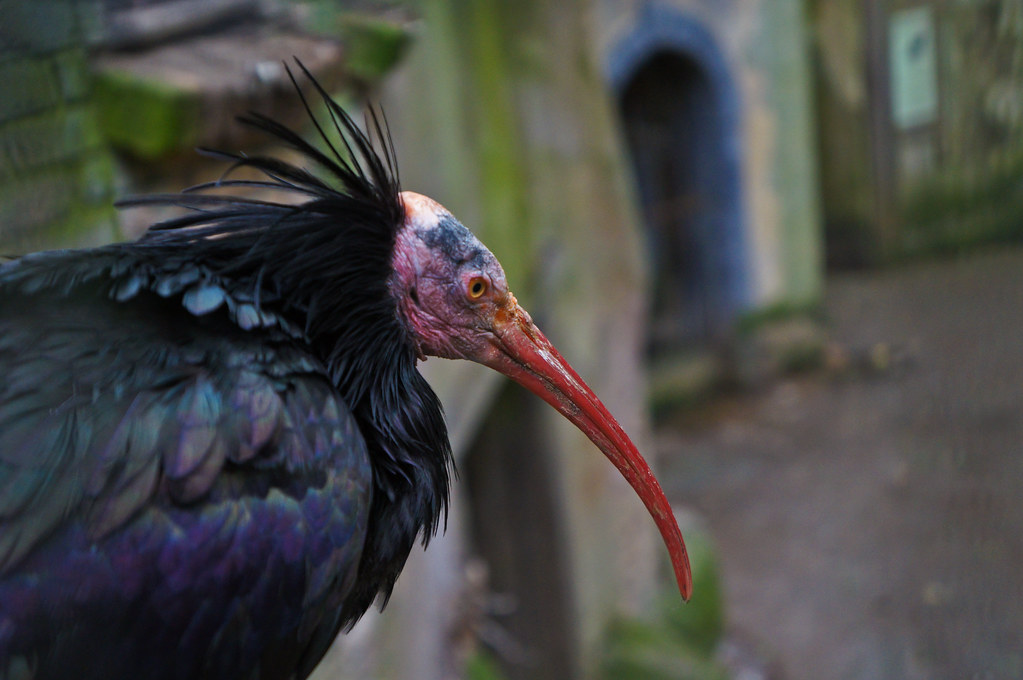
The primary evolutionary advantage of baldness in birds relates to feeding habits and hygiene. For scavengers like vultures that plunge their heads deep into carcasses, a featherless head prevents blood, tissue, and other debris from becoming trapped in facial feathers. This adaptation significantly reduces the risk of bacterial infection that might otherwise occur if rotting material remained stuck to head feathers. Additionally, the clean, featherless surface is much easier to sanitize through simple behaviors like rubbing against surfaces or minimal preening. The bald head also creates less resistance when feeding inside carcasses, allowing for more efficient consumption of carrion. This specialized adaptation demonstrates nature’s elegant solution to the messy business of scavenging.
Thermoregulation Benefits
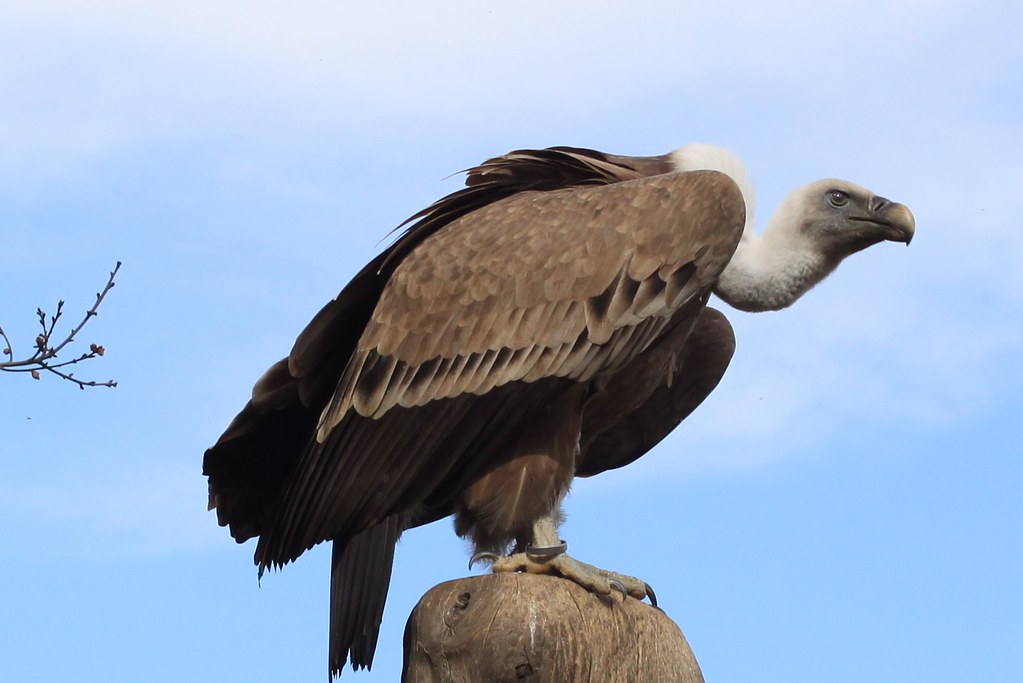
Bald patches on birds serve a crucial thermoregulatory function, particularly for species living in warm climates. Featherless skin allows for more efficient heat dissipation through the process of radiation, helping birds cool down quickly when temperatures rise. This adaptation is especially important for large birds that generate significant body heat during flight or other strenuous activities. Species like marabou storks and lappet-faced vultures can rapidly adjust their body temperature by increasing blood flow to their bare skin areas when overheated, effectively using their bald heads as natural radiators. Conversely, in cooler weather, birds can reduce blood flow to these areas to conserve heat, making the bald patches a versatile temperature control mechanism that works in multiple climatic conditions.
The Turkey’s Unique Case
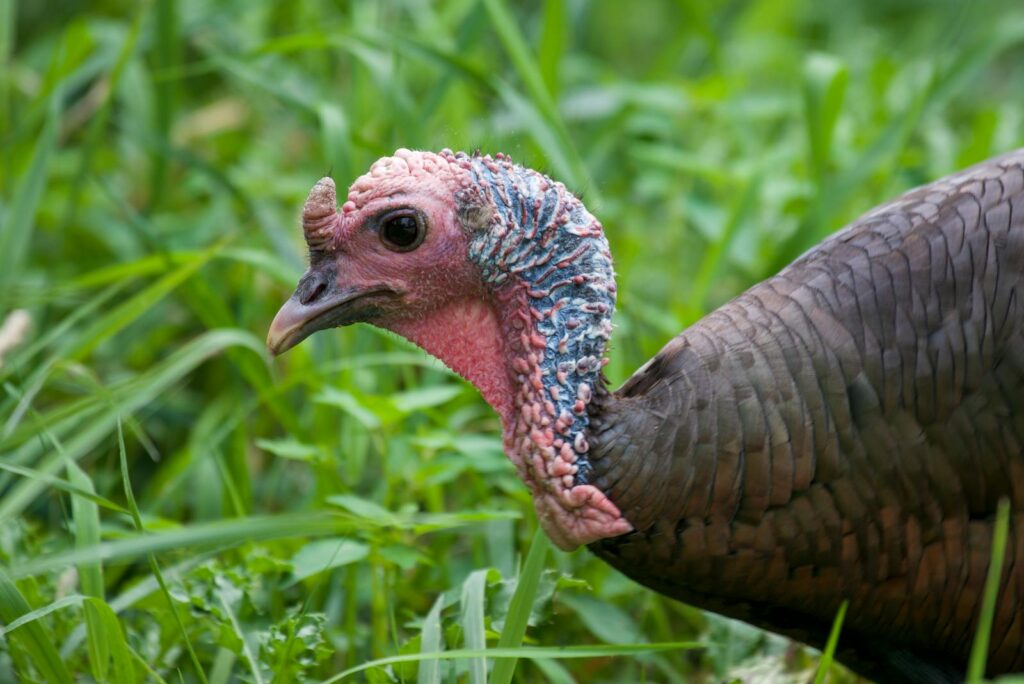
Wild and domestic turkeys represent one of the most recognizable examples of natural baldness in birds, with their distinctive red, blue, and sometimes white bare skin on the head and neck. This featherless feature becomes particularly prominent in male turkeys during breeding season when increased blood flow causes the skin to become more brightly colored and enlarged. The color intensity of a male turkey’s head signals his health and genetic quality to potential mates, with more vibrant colors indicating higher testosterone levels and better overall condition. Beyond sexual selection, turkey baldness also serves practical purposes during feeding and helps with heat regulation when these large birds become active during territorial displays. The adaptable nature of turkey head coloration—changing with mood, health, and season—showcases how these bare patches function as multidimensional communication tools.
Vultures: Masters of Adaptive Baldness
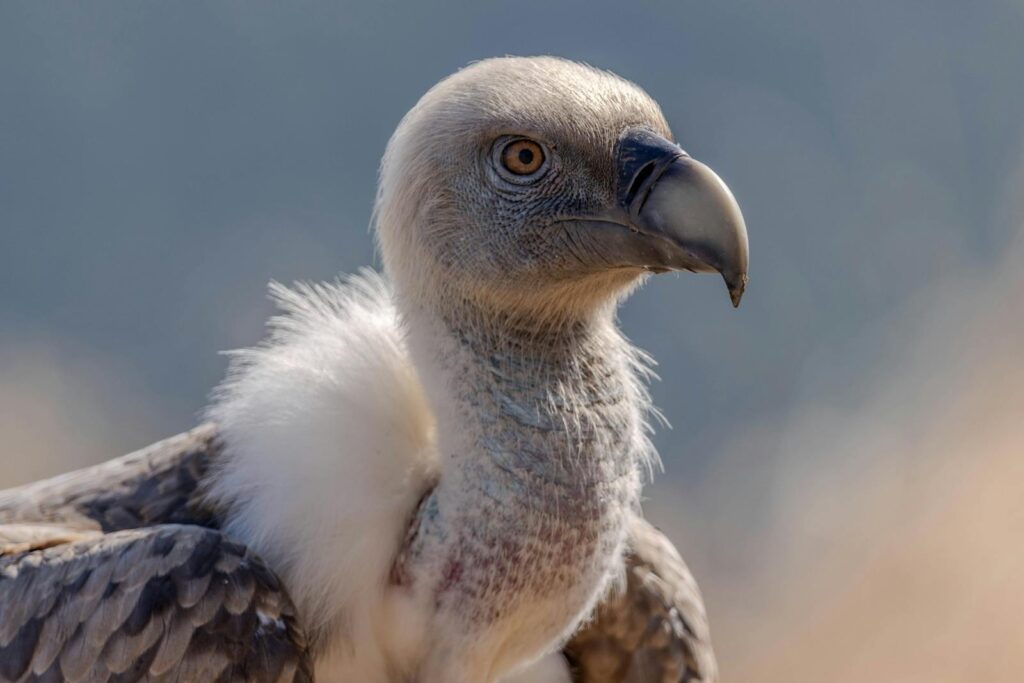
Vultures represent perhaps the most advanced example of evolutionary baldness in birds, with most species sporting completely featherless heads perfectly adapted to their scavenging lifestyle. The Old World vultures of Africa and Eurasia and the New World vultures of the Americas independently evolved this trait—a remarkable example of convergent evolution where unrelated species develop similar characteristics due to comparable environmental pressures. The bare skin of vulture heads ranges from vibrant reds and oranges to subtle pinks, blues, and blacks depending on the species, with each coloration potentially serving communication purposes within vulture groups. Some species, like the king vulture, have developed elaborate skin structures on their bare heads, including colorful wattles and fleshy caruncles that may play roles in species recognition and reproductive signaling. The varying degrees of baldness among vulture species—from the completely bald head of the turkey vulture to the partially feathered head of the bearded vulture—reflect different feeding specializations and environmental adaptations.
Cassowaries and Their Distinctive Casques
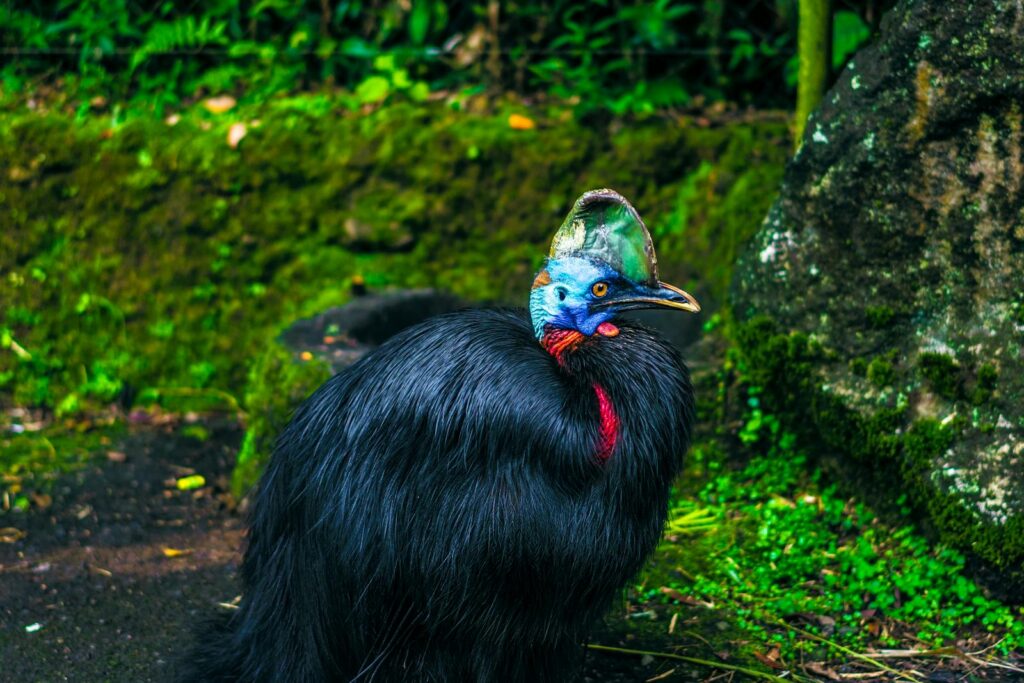
The cassowary, a large flightless bird native to northern Australia and New Guinea, displays one of the most striking examples of natural baldness combined with unique anatomical features. Their featherless heads and necks are adorned with bright blue skin, while a large keratinous casque (helmet-like structure) crowns their heads. This prominent casque was long thought to serve as a protective helmet for moving through dense forest undergrowth, but recent research suggests it may function primarily as a resonating chamber for the bird’s deep booming calls or as a display feature for attracting mates. The bare skin of cassowaries also features colorful wattles that hang from the neck, creating a visually dramatic appearance that likely plays a role in individual recognition and courtship displays. These features, combined with their formidable size and powerful legs, make cassowaries one of the most distinctive examples of natural baldness in the avian world.
Bald Eagles: A Misnomer Explained
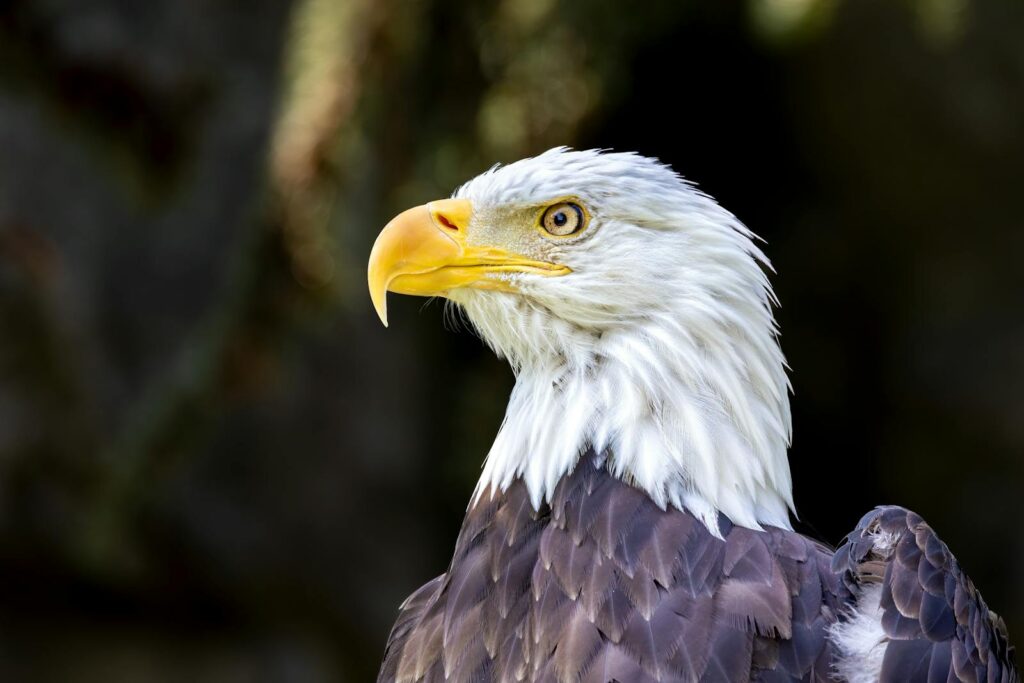
Despite their name, bald eagles (Haliaeetus leucocephalus) aren’t actually bald in the traditional sense of lacking feathers. The distinctive white head feathers of adult bald eagles create a stark contrast against their dark brown bodies, giving them the appearance of baldness from a distance that inspired their common name. The term “bald” in their name derives from an older meaning of the word that referred to white markings rather than featherlessness. Young bald eagles lack this distinctive white head until they reach maturity at around four to five years of age, instead displaying mottled brown plumage throughout their bodies. The white head feathers serve important signaling functions, making adult birds easily recognizable to potential mates and establishing their status in eagle hierarchies. This case highlights how human perception and terminology can sometimes create misconceptions about avian physical characteristics.
Hornbills and Their Bare Facial Skin
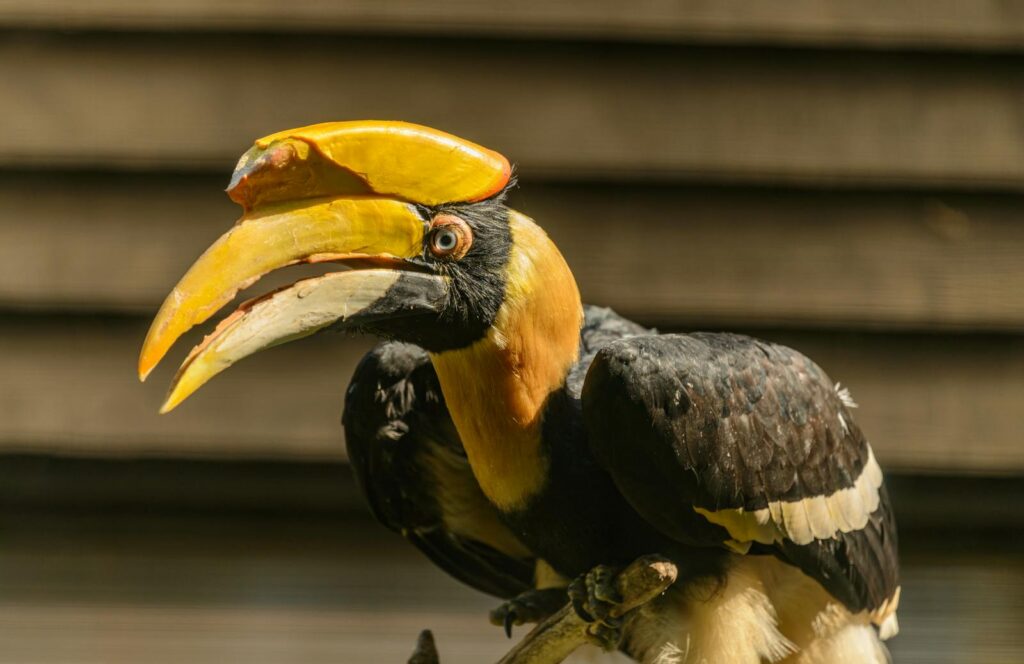
Hornbills comprise a family of birds known for their massive bills and, in many species, patches of bare, colorful skin around their eyes and throats. The bare facial skin of hornbills often appears in vibrant shades of blue, red, yellow, or orange, creating striking visual displays that vary between species. These featherless patches serve multiple functions, from heat regulation in tropical environments to sexual signaling during breeding seasons. In species like the southern ground hornbill, the bare red facial skin can intensify in color when the bird is excited or during courtship displays, functioning as a dynamic communication tool. The contrast between the bare facial skin and the hornbill’s plumage also increases visibility during group foraging activities, helping maintain social cohesion in their forest environments. This family of birds demonstrates how patches of baldness can evolve to serve both physiological and social purposes.
Sexual Selection and Bald Ornaments
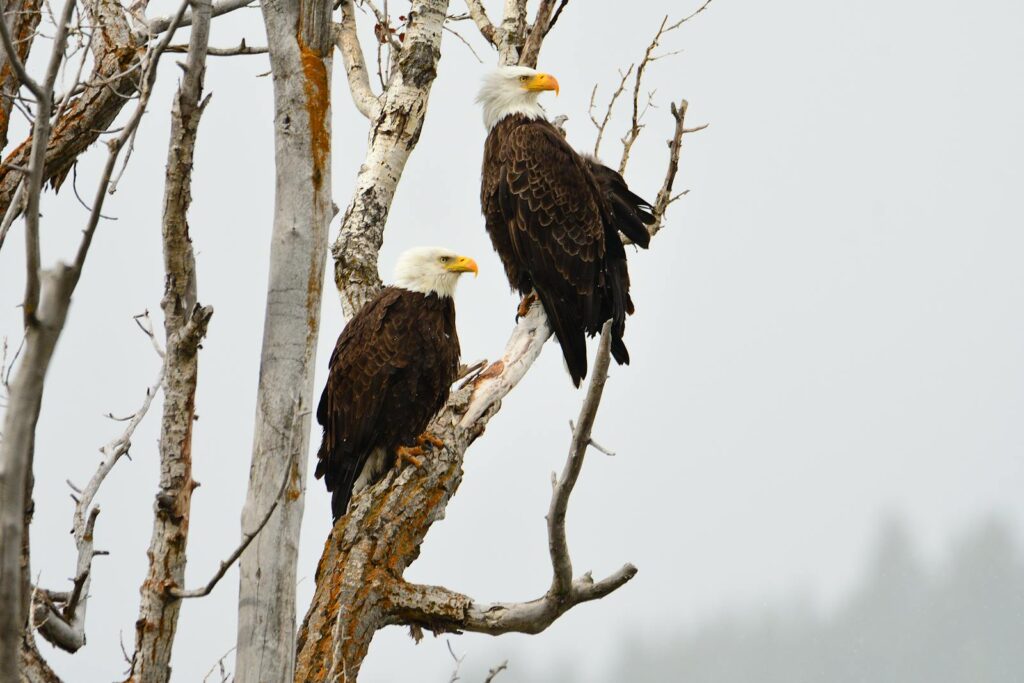
In many bird species, baldness evolved partly through sexual selection—the evolutionary process where certain traits become more common because they provide advantages in attracting mates. Bare skin areas often display more vibrant colors than feathers can achieve and can change color rapidly with shifts in blood flow, creating dynamic signaling possibilities. Male frigatebirds inflate their bright red throat pouches into balloon-like structures during courtship, a dramatic display made possible only through the evolution of featherless skin in this area. Similarly, the male wild turkey’s ability to change his head color from blue to white to red during courtship displays communicates his changing emotional and physiological state to potential mates. Research indicates that females of these species can assess male genetic quality, health, and hormone levels through the vibrancy and color patterns of bare skin areas, making baldness a sophisticated tool for sexual selection. The impressive variety of head ornaments among birds—from the wattles of turkeys to the casques of hornbills—showcases how sexual selection can drive the evolution of elaborate bald structures.
Condors: Baldness in Endangered Giants
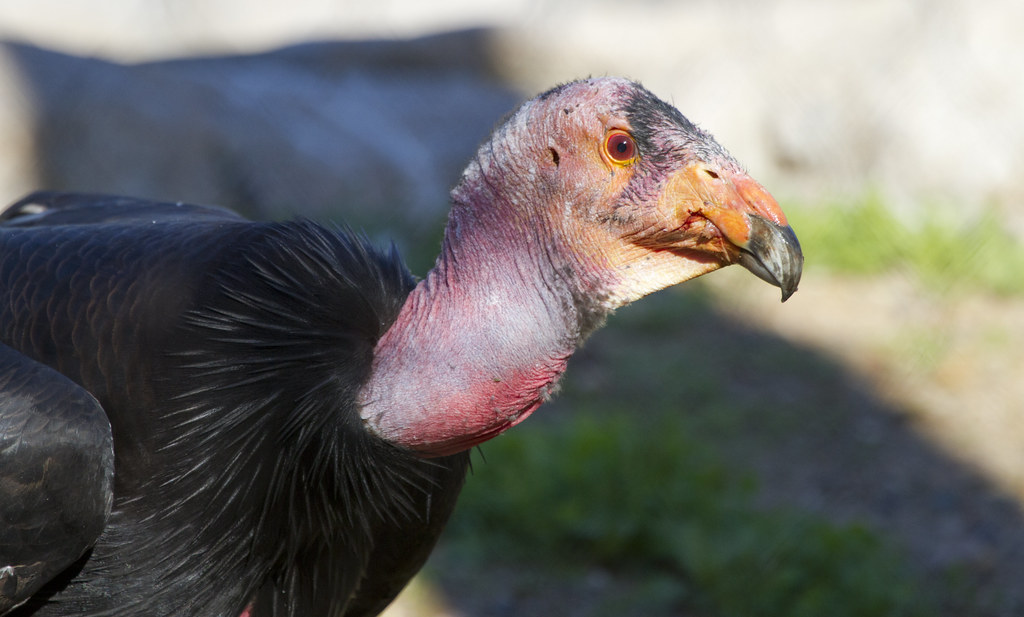
California and Andean condors, among the largest flying birds in the world, exhibit specialized forms of baldness adapted to their roles as nature’s clean-up crew. Their completely featherless heads and necks allow these massive scavengers to feed deep within carcasses without becoming contaminated with blood and tissue that could harbor dangerous bacteria. The bare skin of condors can also change color according to the bird’s emotional state, with blood rushing to the surface during excitement or social interactions, creating a visual communication system. California condors have additional bare skin areas on their crops (expandable food storage pouches) that become brightly colored during courtship and social displays. Interestingly, juvenile condors are born with darkly colored heads that gradually lose pigmentation as they mature, an age-related transition that may signal their developing status within the social hierarchy of these highly intelligent birds.
Storks and Ibises: Bald for Wetland Living
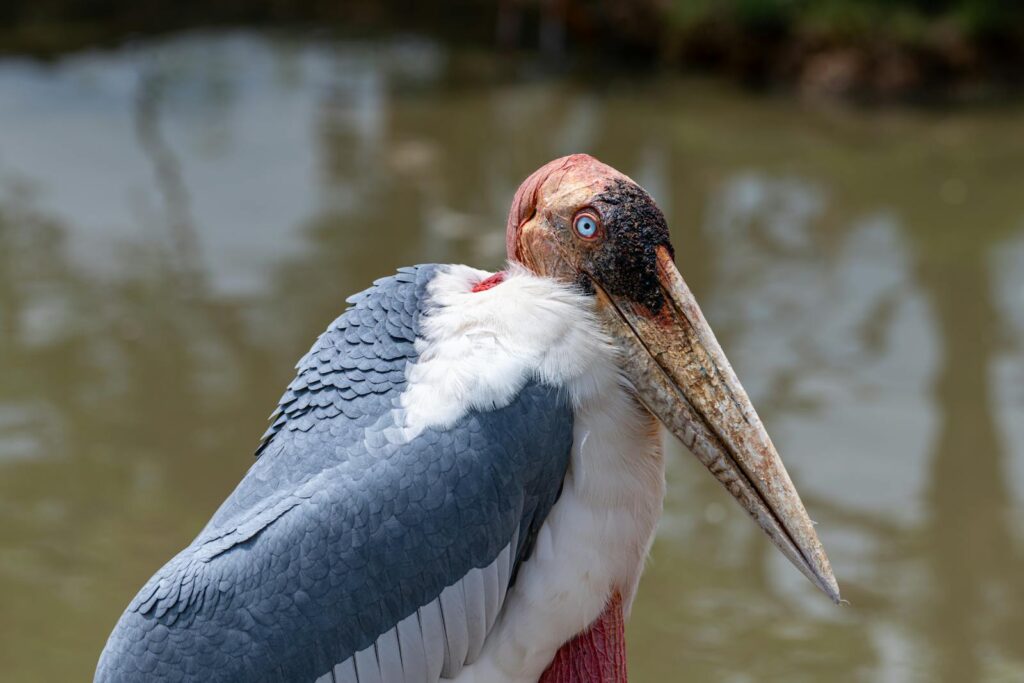
Many stork and ibis species display varying degrees of head and facial baldness specially adapted to their wetland foraging lifestyles. The marabou stork, with its completely bald head and prominent throat pouch, can appear almost prehistoric in appearance. This baldness serves crucial functions when these birds hunt in shallow water and mud, allowing them to keep clean while probing for fish, amphibians, and invertebrates. The sacred ibis, revered in ancient Egyptian culture, features a distinctive black featherless head that contrasts sharply with its white body plumage, possibly serving both thermoregulatory functions and social signaling within colonies. The northern bald ibis, critically endangered in the wild, has a striking red bald head that plays an important role in mate recognition within their complex social groups. These wetland specialists demonstrate how ecological niches can drive the evolution of specialized baldness patterns suited to specific environmental challenges.
Cultural Significance of Bald Birds
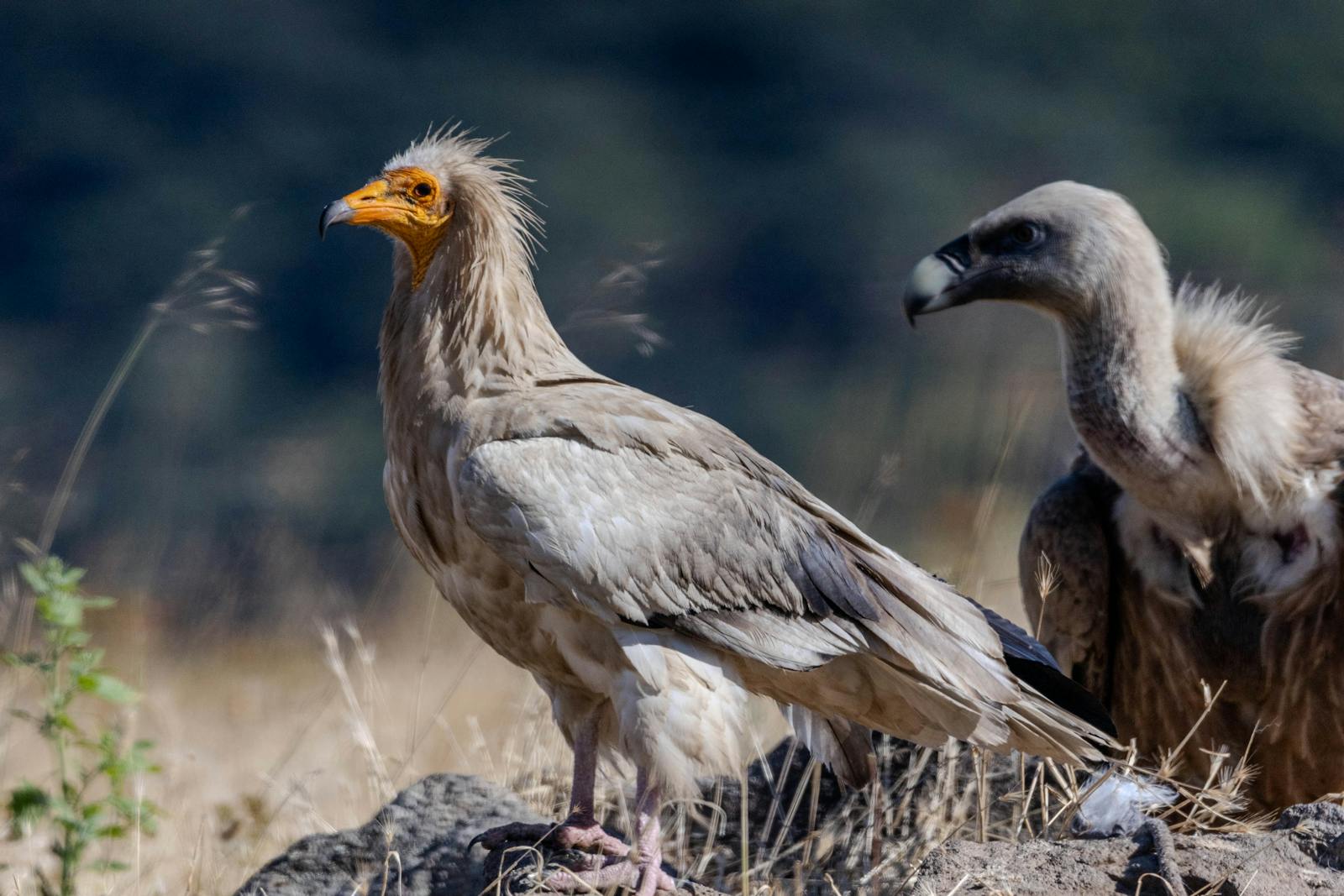
The distinctive appearance of naturally bald birds has made them significant in human cultures throughout history, often representing powerful symbolic meanings. The bald eagle’s white “bald” head made it an ideal national symbol for the United States, representing freedom and strength since 1782. In ancient Egypt, the bald-headed sacred ibis was venerated as a manifestation of Thoth, the god of wisdom and writing, and was frequently mummified as offerings to the gods. Vultures, with their bald heads, have symbolized both death and purification in various cultures, respected for their crucial ecological role despite often being viewed with trepidation. The marabou stork, with its imposing bald head, features in African folklore as a wise but sometimes ominous figure. These cultural associations demonstrate how the distinctive appearance of naturally bald birds has captured human imagination across civilizations and continues to influence our perception of these species today.
Conservation Challenges for Bald-Headed Species
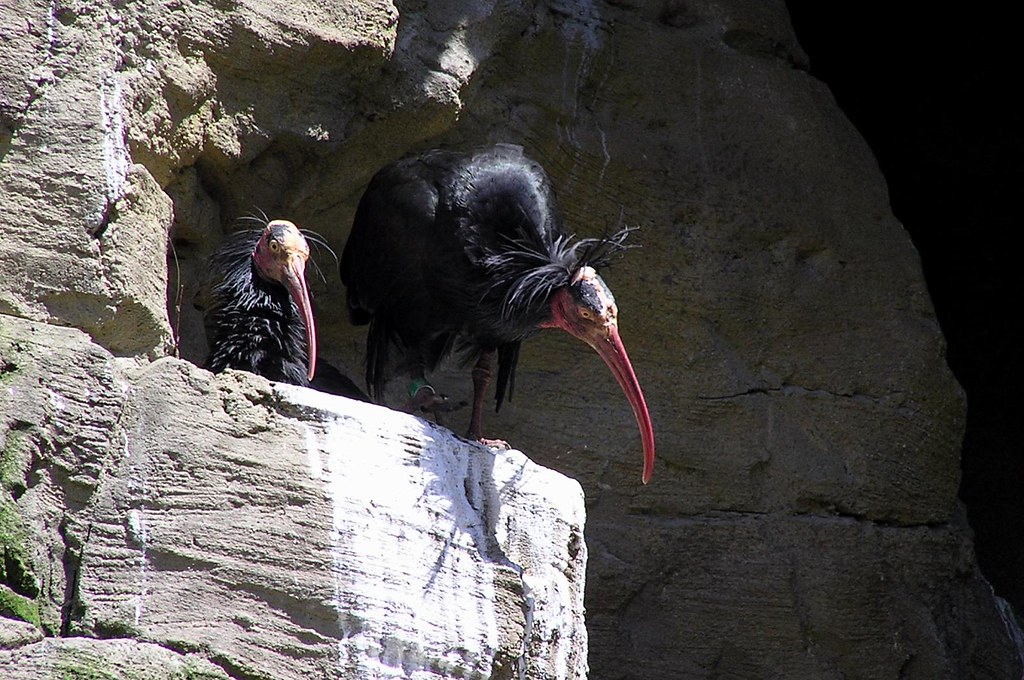
Several naturally bald bird species face significant conservation challenges, with their specialized adaptations sometimes making them vulnerable to environmental changes. The California condor’s bare head made it susceptible to lead poisoning when feeding on carcasses containing lead ammunition fragments, contributing to its near-extinction in the wild before intensive conservation efforts began. The northern bald ibis has declined to critically endangered status partly due to hunting targeted at its distinctive appearance and the destruction of its specialized cliff-nesting habitat. Turkey vultures and other scavengers with bare heads face threats from poisoning, both intentional (when targeted by farmers) and unintentional (when consuming carcasses of animals treated with veterinary drugs like diclofenac). Conservation efforts for these species must address both their ecological requirements and human attitudes toward their sometimes unusual appearance. The recovery of some populations, like the California condor, demonstrates that with dedicated conservation work, these specialized birds can recover from the brink of extinction.
Distinguishing Natural Baldness from Disease
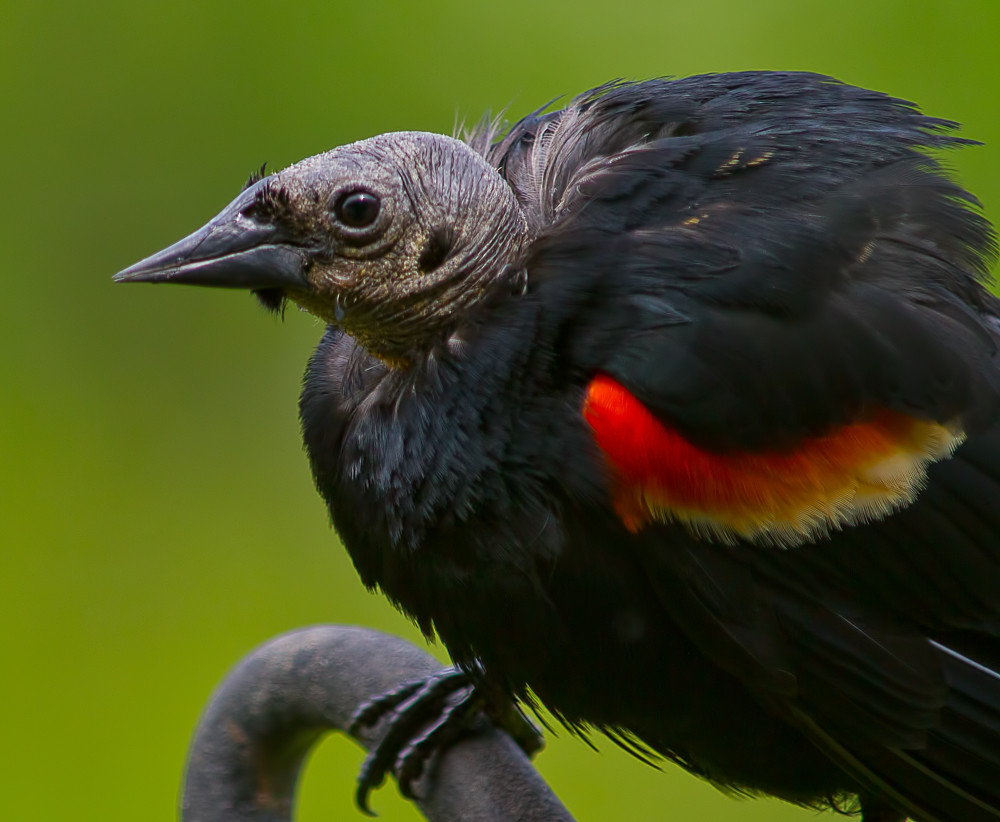
While many birds have evolved to have naturally bald heads or patches, it’s important to distinguish this normal feature from feather loss caused by disease or parasites. Avian pox, mites, and fungal infections can all cause abnormal feather loss that might be mistaken for natural baldness by casual observers. Natural baldness in birds typically presents as smooth, evenly colored skin with clear delineation between feathered and unfeathered areas, while disease-related baldness often appears irregular with inflammation, scabbing, or abnormal skin texture. Pet birds like parrots can develop feather-plucking behaviors due to stress or boredom, creating bald patches that might be mistakenly assumed to be natural. Seasonal changes can also affect the appearance of naturally bald areas, with some species showing more prominent coloration during breeding seasons. Understanding these distinctions helps bird watchers, rehabilitators, and veterinarians correctly identify when baldness represents a natural adaptation versus a sign of health concerns requiring intervention.
The diverse examples of natural baldness across the avian world showcase nature’s remarkable ability to develop specialized adaptations in response to environmental pressures. From the scavenging vulture to the dramatic cassowary, these featherless features serve crucial functions in survival, reproduction, and communication. Far from being a deficiency, avian baldness represents evolution’s elegant solution to specific challenges, allowing birds to thrive in their ecological niches while minimizing the drawbacks that head feathers might present for their lifestyles. As we continue to study these fascinating adaptations, we gain not only a deeper appreciation for avian diversity but also insights into the complex interplay between form and function in the natural world. The next time you spot a turkey’s color-changing head or a vulture’s bare pate, remember you’re witnessing not merely an unusual appearance but a sophisticated biological adaptation honed through millions of years of evolution.
